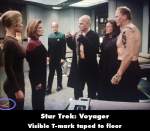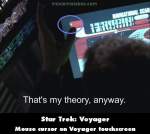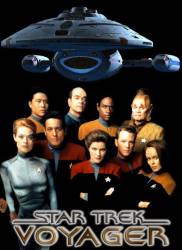
Visible crew/equipment: When the former Borg drones are awakened in sickbay, there's a pinkish T-mark visible on the floor behind Seven, at the bottom left corner of the screen. (00:19:10)
Continuity mistake: When Tom explains to Alice why he can't leave the Voyager, he has a three-day beard. Later in the ship, when Alice convinces him to turn on the neurological interface, he is cleanly shaved. But in the next scene he has his beard back again.
Revealing mistake: As Seven starts to explore, there's a flashlight floating next to her. There's no atmosphere, therefore no breeze, but it's slightly moving before she touches it.
The Voyager Conspiracy - S6-E9
Factual error: When the alien contacts Voyager after his catapult jump, he states that he is 5,000 light years away. Despite the distance, he and Janeway have a real time conversation. With this incredible communications technology, Voyager (which is at this point less than 55,000 light years from the Alpha Quadrant) should be able to have several back and forth conversations a day with Starfleet.
Factual error: Chakotay says "if our orbit starts to decay, Voyager will begin to feel the effects of the differential, and we'll begin aging hundreds of times faster than we would in normal space". Whilst it is true that they would be aging faster relative to normal space, they would not instantly become old. Time would simply slow around them, so whilst they would be aging faster relative to normal space, they would not all of a sudden become really old - which is how it is made out to be. They would all age the same amount whether in a standard orbit or in a more decayed orbit. (00:06:37)
Suggested correction: There is nothing incorrect about what he said. They will start ageing hundreds of times faster than in normal space.
Aging implies getting/feeling older. They'd only be "aging" relative to normal space. What would happen would be more akin to time travel, with the universe getting older around them.
But the point is, they wouldn't age faster just because "normal" time slows down. If they spent a year on the planet, they'd age 1 year, not 100 years.
Plot hole: When orbiting the planet, Seven says that for every second on Voyager, nearly a day passes on the planet and later Janeway says 3 seconds is nearly 2 days. However, throughout the episode, time seems to move much faster on the planet to fit the plot. It would take more than 6 days for 1,000 years to pass. And in a few hours (3) less than 20 years would pass (hardly enough time for the rise and fall of a civilization). For example, when they receive the transmission, they slow it down and immediately start playing it. The next scene the senior officers are listening to it and the Doctor says nearly a century has passed, but there's no reason (or indication) that they waited almost 15 hours to listen to it.
Revealing mistake: If you look closely at the hot air balloon, in the shot before the message is attached to it, you can just see a wire holding it up.
Character mistake: B'Elanna replicates and assembles a television from 1956, including a remote control. Tom however says they didn't have remote controls in the 50's. The first wireless remote was invented in 1955 and the "Zenith Space Command" (a remote looking similar to the one in use) came out in 1956, which fits the timeline. Tom is vastly aware of 1950's technology (he seems to know when the television remote came out) and wouldn't make that mistake or B'Elanna would have corrected him given how much research she had to do to set the whole thing up.
Continuity mistake: When Harry uses the scanning tool, the lights alternate between flashing from top down to bottom up and back between angles.
Spirit Folk - S6-E17
Plot hole: Gunfire damages the holodeck controls, and the computer announces that safety protocols are now offline. This implies that they were online before the gunfire. If they were still online before the gunfire, the bullets would not have damaged the controls.
Suggested correction: Safety protocols are meant to protect the real people in the simulation, holobullets would still cause damage to non-real people and objects.
Character mistake: When the now human Borg children are sculpting, one of the children tell Seven he made a cube that's precisely 1/1,000 the size of a Borg vessel. Borg Cubes are described as 3 kilometers in length, if not bigger. 1/1,000 of that would be more than 9.8 feet in length. 1/10,000 the size would have been a more accurate description.
Revealing mistake: As Icheb's parents turn their faces towards the sun to look at Icheb, the edges of the prosthetics used for the ridges on their noses are visible.

Revealing mistake: Right at 40:30, if you look in the top left corner of the LCD screen, you can see a mouse cursor. Six seconds later it starts to move around. It seems like someone noticed and tried to move it out of the scene. (00:40:30)
Live Fast and Prosper - S6-E21
Other mistake: As Captain Janeway enters engineering after her sonic shower incident you hear crew members calling out problems on the ship. One mentions something about Deck C and another mentions a problem on Deck 22. Letters are not used to designate decks and there are only 15 decks on Voyager. (00:06:30)
Continuity mistake: When future Kes is talking to Neelix in the kitchen, when he says he's already reserved the holodeck, he's holding the smaller container. In the next shot, the smaller container is on the counter and he's holding the bigger pot.
Other mistake: When Janeway plays the message from the Admiral, she tells the computer to advance to time index 121.4. each 0.1 of the time index equals 1 second. We hear the message play for 4-5 seconds, but when the video is shown, the time index is only 121.5.
The Haunting of Deck Twelve - S6-E25
Character mistake: When Chakotay states they have collected 80% of deuterium and he suggests to stop taking in more, Captain Janeway agrees and she then tells B'Lana that they will stop taking in dilithium. (00:09:50)





